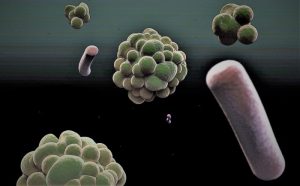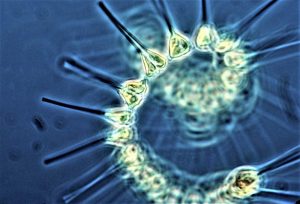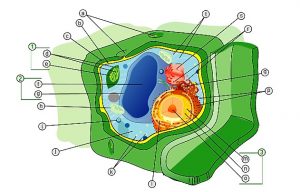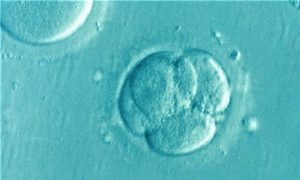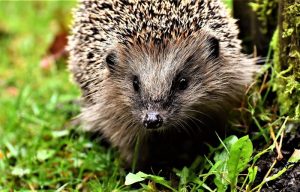Microorganisms
A microorganism is a living being whose size is too small to be seen by simple sight. Examples of microorganisms include bacteria, arches, algae, protozoa and microscopic animals such as the dust mite. These microorganisms have generally been underestimated and very few of them have been studied. In fact, it was not until Anton Von Leeuwenhoek invented the microscope that its existence was not even known. Until then, scientists used to think that phenomena related to disease and food spoilage were caused by certain types of vapors or by the well-known theory of spontaneous generation.
What are microorganisms?
Microorganisms are very tiny beings that can only be seen through the use of microscopes. They are beings that have only one cell and are responsible for food spoilage and disease.
History
Microbiology has had a long and rich history, initially focusing on the different causes of infectious diseases, but now, it includes practical applications of science. Many people have made important and significant contributions to the development of microbiology. Historians are not yet sure who made the first observations of microorganisms, but it is known that the microscope was available in the mid-17th century, and during that time, there was an English scientist named Robert Hooke who made some key observations. He was well known and famous for observing strands of fungi between the cell specimens he saw. In the 1670s and later decades, a Dutch merchant named Anton van Leeuwenhoek made careful observations of microscopic organisms, which he called animalcules. Until his death in 1723, van Leeuwenhoek revealed the microscopic world to the scientists of the time and for this reason he is considered one of the first to provide accurate descriptions of protozoa, fungi and bacteria.
What are microorganisms for?
Microorganisms are also important to human life. Different health benefits have been discovered by scientists. It has been shown that children have a large amount of bacteria in their faeces, which in fact make them healthier. The use of probiotics helps maintain a microbial balance in the intestines as well. For these reasons, microorganisms are considered beneficial to humans because they improve nutrition and play important specific therapeutic roles.
Characteristics
The most notorious are the following:
- Microorganisms are small.
- They have a close relationship between surface and volume.
- Their metabolic reactions are quite large and rapid.
- Microorganisms are transported through membranes and cell diffusion is very fast.
- They alter the environment of the surrounding with abrupt and rapid changes,
- They create micro ecological niches.
- They are able to develop resistance and dispersion
- They are capable of surviving great depths and many years when buried several meters away.
Classification
The classification of microorganisms is given through microbiology, so it is possible to classify the four groups:
- Bacteria: They have no nucleus and only one chromosome; they can be multiplied by bipartition, conjugation, transformation and transduction. They receive their name according to their form, if they are cylindrical they will be bacilli, if they have rounded form they are coconuts, those of helicoidal aspect will be the spirals, and the shorts and curved ones with coma form will be denominated vibrios.
- Viruses: Cannot be nourished, related or reproduced by themselves, so they are considered parasites. According to their form they can be icosahedrons if they present a spherical, helical or cylindrical form if they are elongated, and the complexes that are formed by two parts a head and a tail.
- Fungi: They are unicellular or pluricellular eukaryotic microorganisms, heterotrophs and saprophytes. Their reproduction is by twinning, sporulation or fragmentation in the extracellular medium and they are classified into yeasts or fungi.
- Parasites: They are eukaryotes, classified into protozoa and helminths.
Functions
They are used both in the field of industry and in the production of food and medicines. They are indispensable within the ecosystem because they are in charge of carrying out the biogeochemical cycles. They are capable of converting organic matter into waste, which is transformed to be used again by autotrophs. They can convert molecular nitrogen into forms that plants can assimilate.
Food
They are used for the manufacture of certain types of food, for the fermentation of fruits and vegetables, for the creation of beverages, in the manufacture of milk derivatives such as cheese and yogurt.
Reproduction
Microorganisms can reproduce sexually and asexually. Asexual reproduction is characterized by the fact that different biological mechanisms must be involved in order for it to occur correctly, whether by binary fission or gemmation. Sexual reproduction occurs when DNA is combined with other cells and is also known as parasexual phenomena.
Examples
- Rhinovirus
- H1N1
- Rotavirus
- Mycobacterium
- Escherichia coli
- Proteus mirabilis
- Papilloma virus
- Yeast
Pathogenic microorganisms
Are those microorganisms that are capable of causing diseases and infections in the organism in which they are living. They exist from those that produce illnesses inside a hospital that are known as nosocomial, to those that are of benefit for our body as the saprophytes. The most important are: bacteria, viruses, protozoa, fungi and prions.
Beneficial microorganisms
These are the organisms that inhabit in symbiosis with the human, for example, the intestinal flora. They are bacteria that inhabit our interior but at the same time receive protection and food. There are also microorganisms that live in the soil that help to fix atmospheric nitrogen, beneficial for plants.
How to cite this article?
Briceño V., Gabriela. (2019). Microorganisms. Recovered on 23 February, 2024, de Euston96: https://www.euston96.com/en/microorganisms/
